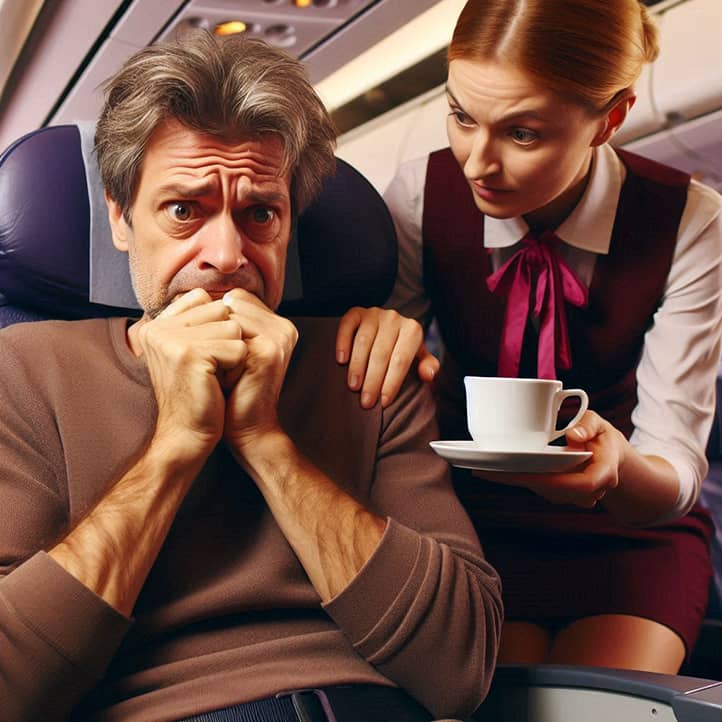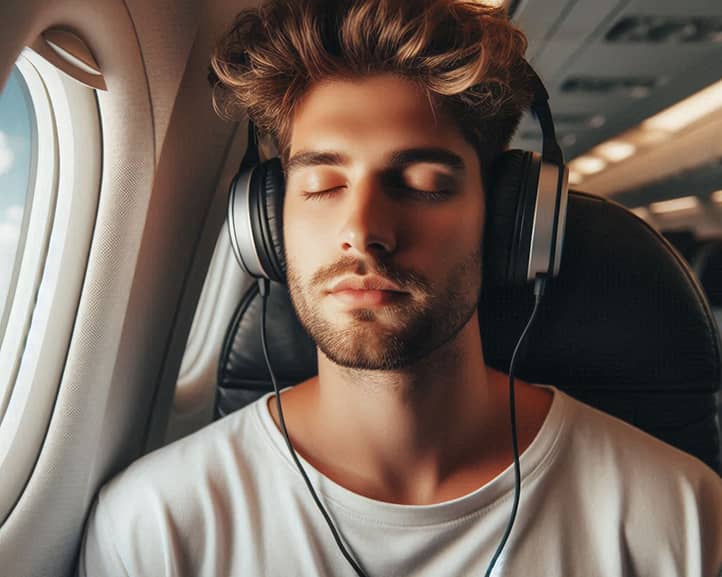Aerophobia is an irrational fear of flying that can manifest even before a person boards an airplane. It is not just mild pre-travel anxiety but a serious psychological barrier often accompanied by physical and emotional symptoms. Aerophobia falls under specific phobias that can complicate daily life, limiting an individual’s ability to travel or even work if their job requires frequent air travel.
Statistics show that aerophobia is among the most common phobias worldwide. Studies indicate that about 25% of people experience varying degrees of anxiety during flights, and approximately 10% avoid air travel entirely due to intense fear. This fear can affect both first-time flyers and seasoned travelers who may have had a traumatic experience or heard unsettling stories. Aerophobia impacts individuals regardless of age, gender, or social status, although its symptoms are more commonly seen in adults.
Overcoming aerophobia is essential for those seeking an active and fulfilling life. In today’s world, air travel is the fastest and most convenient way to explore new opportunities, from visiting exotic destinations to attending international events or working abroad. Fear of flying can significantly restrict mobility, leading to lost opportunities for personal growth, leisure, and connection with others.
Additionally, prolonged avoidance of flying may exacerbate the phobia, making it more intense and harder to overcome. Conquering this fear, on the other hand, not only grants freedom of movement but also boosts self-esteem, enhances stress resilience, and improves overall quality of life. Overcoming aerophobia becomes a symbol of personal growth and triumph over inner barriers.

Primary Causes of Aerophobia
Aerophobia can arise from various factors that affect a person’s emotional and physical state. Although fear of flying seems like a purely psychological issue, it often has deeper roots tied to biology, past experiences, or external influences. Understanding the causes and mechanisms behind aerophobia is crucial for successfully addressing it.
Everyone perceives air travel differently: for some, it’s an adventure, while for others, it’s a source of stress and challenge. The reasons behind aerophobia can be both individual and universal. Often, the fear stems from a combination of factors, including physical reactions, negative associations with flying, or societal influences.
Here’s a closer look at the primary causes of aerophobia:
Fear of Heights and Enclosed Spaces
One of the most common causes of aerophobia is the combination of a fear of heights (acrophobia) and claustrophobia. People afraid of heights feel anxious at great elevations, even in safe conditions like an airplane. The sensation of being disconnected from the ground and unable to control the situation can trigger panic.
Claustrophobia adds another layer of fear with the dread of confined spaces. An airplane passenger cannot leave, stretch, or change their surroundings, which creates additional discomfort. A cramped cabin, crowded conditions, and lack of fresh air can significantly heighten anxiety.
Negative Experiences or Traumatic Events Related to Flying
Personal experiences play a significant role in developing aerophobia. For instance, someone may have endured severe turbulence, an emergency landing, or a particularly unpleasant flight, leaving lasting negative memories. Even if such situations were not life-threatening, they could have triggered a fear that later becomes associated with every flight.
Traumatic events do not necessarily have to involve the individual directly—accounts from other passengers or stories heard from acquaintances can also lay the groundwork for fear. This is especially true for highly empathetic individuals who easily absorb others’ emotions.
Media Influence on the Perception of Aviation Risks
Mass media, including movies, news, and social media, significantly shape people’s perceptions of aviation. Disaster films, documentaries about air crashes, or sensational news about tragedies in the skies leave a strong emotional impression.
These portrayals often exaggerate the dangers of flying, emphasizing rare but dramatic events. As a result, many people develop a distorted view of flight risks, leading to irrational fear.
Biological and Psychological Factors
Individuals with heightened anxiety levels or a predisposition to panic attacks are more likely to suffer from aerophobia. This is because their nervous systems respond more sensitively to stressful situations, even if they are objectively safe.
Phobias may also stem from genetic predisposition or childhood experiences. For example, if a child overheard their parents expressing fear of flying or witnessed their reactions during air travel, this could imprint on their subconscious.
Biological reactions, such as increased heart rate, dizziness, or hyperventilation, often act as triggers for aerophobia. A person might not associate these symptoms with their thoughts but feel that something is “wrong” with their body, intensifying fear and anxiety.

How Aerophobia Manifests?
Aerophobia is not just a fear of flying but a complex combination of physical, emotional, and behavioral reactions that affect a person’s daily life. Its manifestations can range from mild nervousness to full-blown panic attacks. Depending on the severity of the fear, symptoms may appear before a flight or during the experience itself.
It’s important to understand that aerophobia impacts three main spheres: physical, emotional, and behavioral. This means that a person not only experiences fear but also undergoes bodily changes, harbors negative thoughts, and may drastically alter their lifestyle to avoid flying.
Physical Symptoms
Physiological responses are often the first signs of aerophobia. A person might not even realize they are experiencing fear, but their body reacts to stress. Common physical symptoms include:
- Rapid heartbeat: A strong pulse or tachycardia occurs due to an adrenaline surge. This is the body’s natural reaction to perceived danger, even if the threat is imagined.
- Sweating: Hands, face, or the entire body may sweat profusely as a result of the sympathetic nervous system responding to stress.
- Trembling: Hands or legs might shake due to muscle tension caused by anxiety.
- Breathing difficulties: Shortness of breath or hyperventilation may occur, especially during a panic attack.
- Gastrointestinal issues: Nausea, stomach pain, or digestive upset are common stress-related symptoms.
These physical signs not only cause discomfort but can also heighten anxiety as the person begins to worry something might be wrong with their body.
Emotional and Cognitive Reactions
On an emotional level, aerophobia manifests as fear, anxiety, or even panic, often accompanied by negative thoughts that intensify the phobia.
- Panic: During a panic episode, a person may experience uncontrollable fear, loss of composure, and an urgent desire to leave the plane or avoid flying altogether.
- Negative thoughts: Individuals with aerophobia often imagine worst-case scenarios, such as plane crashes, mechanical failures, or pilots losing control. While these thoughts are irrational, they feel real to the person experiencing them.
- Exaggerated risk perception: Even when presented with information about the high safety of air travel, individuals with aerophobia tend to focus on potential dangers, maintaining their fear.
Emotional and cognitive symptoms often lead to behavioral changes aimed at avoiding flights.
Avoidance of Flying as a Behavioral Outcome
One of the most noticeable signs of aerophobia is a change in behavior, specifically aimed at avoiding flight-related situations. A person might:
- Refuse to travel: Whether it’s a business trip or vacation, fear prompts them to choose alternative transportation, such as ground travel.
- Cancel or postpone flights: In extreme cases, the individual might cancel a flight at the last minute, even if it causes financial or logistical inconvenience.
- Plan routes without flights: People with aerophobia often limit their travel to destinations accessible by train or car.
Thus, aerophobia has multifaceted manifestations, encompassing physical symptoms, deep emotional reactions, and significant behavioral changes. Understanding these manifestations is an essential first step in overcoming the fear of flying.

How to Overcome Aerophobia: Methods of Conquering Fear
Aerophobia can significantly limit a person’s life, preventing them from traveling, visiting loved ones, or attending important work trips. However, modern psychology and self-help approaches offer a wide range of effective methods to combat the fear of flying. Overcoming aerophobia is possible with a combination of knowledge, practical skills, and support from professionals.
Each method addresses different aspects of fear, from gaining knowledge about flights to directly working with emotions and thoughts. Individuals can choose the approach that best suits their needs or combine several methods for better results.
Gaining Knowledge About Flights
One of the main causes of aerophobia is a lack of understanding of how airplanes work and an overestimation of risks. Learning about aviation can help change perceptions and reduce anxiety.
- Principles of Aviation: Learning how airplanes fly, why they remain stable even during turbulence, and how engines and safety systems operate is an important step. Fear often stems from the unknown, but technical knowledge dispels irrational fears.
- Safety Statistics: Air travel is one of the safest modes of transportation. Statistically, the likelihood of an aviation accident is extremely low. Regularly reminding yourself of these facts can be reassuring. For instance, the risk of a car accident is much higher, yet people rarely fear driving.
Relaxation Techniques
Relaxing the body and mind is crucial in managing anxiety. Regular practice of relaxation techniques can reduce tension and help control emotions during a flight.
- Breathing Exercises: Slow, deep breathing helps stabilize heart rate and calm the nervous system. Techniques like “4-7-8” breathing (inhale for 4 counts, hold for 7, exhale for 8) effectively reduce anxiety.
- Meditation: Mindfulness practices help distract from fear and focus on the present moment. During a flight, you can use audio meditations or dedicated apps.
- Progressive Muscle Relaxation: This technique involves alternately tensing and relaxing different muscle groups. It helps release physical tension often associated with fear.
Cognitive-Behavioral Therapy
Cognitive-behavioral therapy (CBT) focuses on changing destructive thought patterns that sustain the fear of flying. By addressing cognitive distortions, individuals can begin to perceive flights as safe.
- Analyzing Negative Thoughts: A psychotherapist helps identify irrational beliefs, such as “The plane will definitely crash” or “I won’t be able to get out of the plane.” These thoughts are then replaced with more realistic and positive ones.
- Exposure Therapy: This approach gradually exposes individuals to their fear. For example, they might start by watching videos of flights, visiting an airport, and eventually boarding a plane. This allows them to adapt to the situation and reduce anxiety.
- Developing New Behavioral Models: During therapy, individuals learn to respond differently to fear, such as using relaxation techniques instead of avoidance.
Professional Support
Working with a psychologist or psychotherapist is an effective way to overcome aerophobia, especially if the fear is severe.
- Psychotherapy: Intensive sessions help address the root causes of fear and teach effective coping strategies.
- Group Therapy: Participating in support groups with others who experience aerophobia provides reassurance that one is not alone in their fears. Sharing experiences and strategies can be invaluable.
- Courses Offered by Airlines: Some airlines offer special programs that teach passengers about flight principles, conduct anxiety management training, and organize introductory flights.
Self-Help Resources
In today’s world, many resources are available to help individuals independently cope with aerophobia.
- Mobile Apps: Specialized programs like SOAR or SkyGuru provide information about flights, offer relaxation exercises, and help manage fear in real time.
- Books and Videos: Reading about aerophobia or watching documentaries about aviation can inspire confidence and debunk myths.
- Audiobooks and Podcasts: These can help calm and distract during a flight, especially if they address overcoming fears.
Overcoming aerophobia is an achievable goal. The key is to find the right approach and not hesitate to seek help. Each method brings individuals closer to transforming flights from a source of fear into an opportunity for new experiences.

Practical Tips Before Flying
Preparing for a flight can significantly influence how comfortable and calm you feel during your journey. A thoughtful approach helps reduce stress associated with air travel and makes the experience more enjoyable. Whether you’re flying for the first time or overcoming a fear of flying, simple yet effective tips can boost your confidence.
Careful planning, attention to personal comfort, and readiness for unexpected situations can help minimize anxiety. It’s especially important to understand that even in cases of turbulence or other unusual occurrences, you can remain calm and maintain control over your emotions.
Choosing the Right Time and Seat on the Plane
One way to ensure a more comfortable flight is by carefully selecting the flight time and your seat on the plane.
- Flight time: Morning flights are often smoother since turbulence is generally less intense at this time. Additionally, morning flights are less likely to be delayed, helping you avoid unnecessary stress.
- Seat selection: If you want to minimize the sensation of movement, choose seats near the wings—this is the plane’s center of gravity, where turbulence is least noticeable. Those who fear heights may prefer aisle seats to avoid looking out of the window. Extra legroom seats can also provide added comfort during long flights.
Preparing for the Flight: Essentials for Comfort
Having the right items on hand helps create a sense of control and comfort, even in an unfamiliar situation.
- Documents and necessities: Keep your passport, ticket, and other essential documents easily accessible. Include water (if allowed by regulations), snacks, headphones, and a charger in your carry-on.
- Relaxation aids: Bring an eye mask, earplugs, or noise-canceling headphones to reduce distractions. A travel pillow and a warm sweater can also enhance your comfort.
- Entertainment: Download favorite movies, podcasts, or books to your smartphone or tablet. This can distract you from anxious thoughts and make the time more enjoyable.
Staying Calm During Turbulence
Turbulence is a normal part of air travel and poses no danger. However, for many people, it’s the most anxiety-inducing aspect of flying.
- Understanding turbulence: It occurs due to changes in air currents and does not threaten the plane, which is designed to handle such conditions. Knowing this fact can be reassuring.
- Physical techniques: Practice box breathing or progressive muscle relaxation to reduce anxiety levels.
- Emotional control: Instead of focusing on fears, try to shift your attention to something else—music, a book, or a conversation with a fellow passenger. Positive thoughts and an awareness that turbulence is temporary can help you stay calm.
- Crew support: If turbulence causes significant discomfort, don’t hesitate to reach out to the cabin crew. Their explanations and reassurance can often help you cope with fear.
Preparation is a vital part of overcoming the fear of flying. Choosing the right flight time and seat, carefully planning items for comfort, and knowing techniques to stay calm during turbulence can help reduce stress and make travel enjoyable. Confidence in yourself and understanding how to act in any situation are key to overcoming aerophobia.

Benefits of Overcoming Aerophobia
Overcoming aerophobia opens up new life opportunities that once seemed unattainable. The fear of flying not only limits the ability to travel but also impacts self-confidence. Freeing yourself from this fear allows you to broaden your travel horizons, gain new experiences, strengthen your self-assurance, and enhance your overall quality of life.
Broadening Travel Horizons
Conquering the fear of flying enables unrestricted travel.
- Access to remote destinations. Airplanes are the only way to reach many regions, such as tropical islands, countries on other continents, or remote cities. By overcoming aerophobia, you can explore cultures, traditions, and natural wonders that are inaccessible in your area.
- Speed and comfort. Flights significantly reduce travel time, allowing you to spend more time enjoying your vacation or focusing on work. For instance, instead of spending several days on a train or driving, a flight takes only a few hours.
- Expanding opportunities. By removing the barrier of fear, you can confidently plan business trips or visit friends across the globe. This opens doors to professional growth, social interactions, and exciting adventures.
New Experiences and Insights
Flying provides unique sensations and offers a fresh perspective on the world.
- Exploring the world. Overcoming aerophobia allows you to see iconic landmarks, natural wonders, and participate in events happening abroad. For example, visiting Paris to see the Eiffel Tower or witnessing the Northern Lights in Norway.
- Cultural awareness. Traveling exposes you to new cultures, languages, and cuisines, enriching your worldview and broadening your understanding of the world.
- Emotional satisfaction. Overcoming fear and being able to fly brings joy to your travels. Each new experience gained during a journey becomes a treasured memory, inspiring future achievements.
Boosting Self-Confidence
Facing fears is an essential step toward personal growth.
- Overcoming limitations. Conquering aerophobia is an achievement that demonstrates your ability to tackle challenges. It not only aids in travel but also inspires you to face other fears.
- Building self-esteem. Confidence in your ability to manage emotions strengthens your self-esteem. You start feeling capable of handling life’s challenges.
- Enhancing resilience. The ability to overcome a phobia makes you more adaptable to other stressful situations, which is a critical skill in today’s fast-paced world.
Overcoming aerophobia is a path to freedom, new experiences, and a more confident approach to life’s challenges. Every step taken toward overcoming this fear is an investment in your future, filled with discoveries and victories.

Conclusion
Aerophobia is not a life sentence but a temporary barrier that can be overcome with determination, knowledge, and a systematic approach. The fear of flying, though it may seem like a significant obstacle, is just one of many challenges a person encounters in life. It is important to recognize that this barrier is not insurmountable. Instead of avoiding flights and limiting yourself, take the first step toward resolving the issue. Beyond that step lies a world of incredible adventures, diverse cultures, and vivid impressions.
Overcoming aerophobia requires patience and persistence. It is a gradual process that demands consistency, as fears do not disappear instantly. Educating yourself about aviation, practicing relaxation techniques, or working with a specialist can help reduce anxiety levels and gradually restore confidence. The key is to keep moving forward, even when difficulties arise. Every small success, such as a smooth short flight or staying calm during turbulence, becomes a step toward progress.
Travel is more than just moving between destinations. It opens up a new dimension of life: exploring the cultural heritage of other countries, learning traditions, witnessing natural wonders, and expanding your horizons while drawing inspiration from new experiences. Realizing that this amazing world is waiting for you encourages you to overcome any obstacles, including the fear of flying.
When fear gives way to confidence, you begin to feel true freedom. Conquering aerophobia not only frees you from limitations but also strengthens your inner resolve. Each flight you overcome serves as a reminder that fears are temporary hurdles, while your dreams and aspirations are worth the effort. The new adventures, impressions, and memories you gain through travel will be the best proof that life is an endless journey filled with opportunities and joy.




